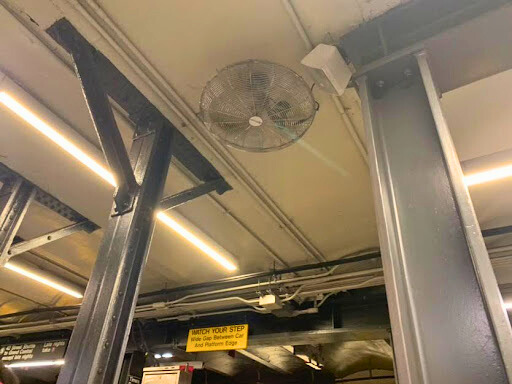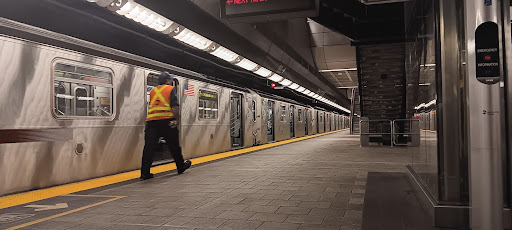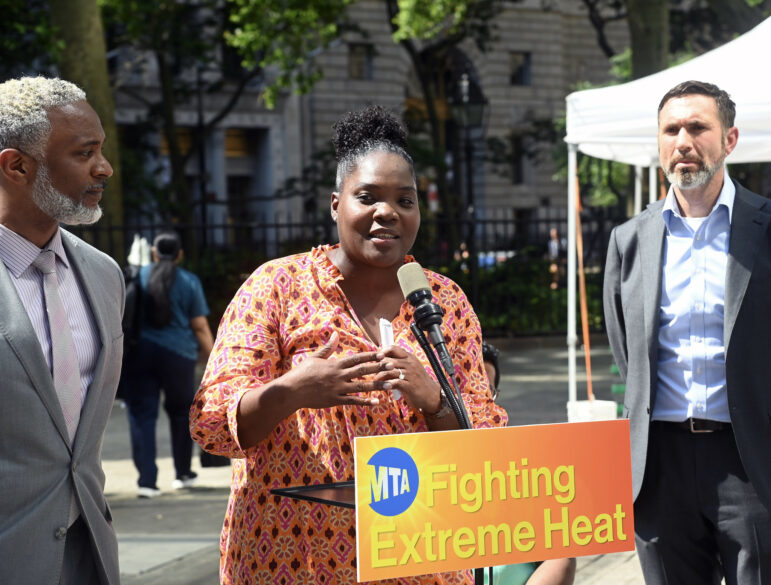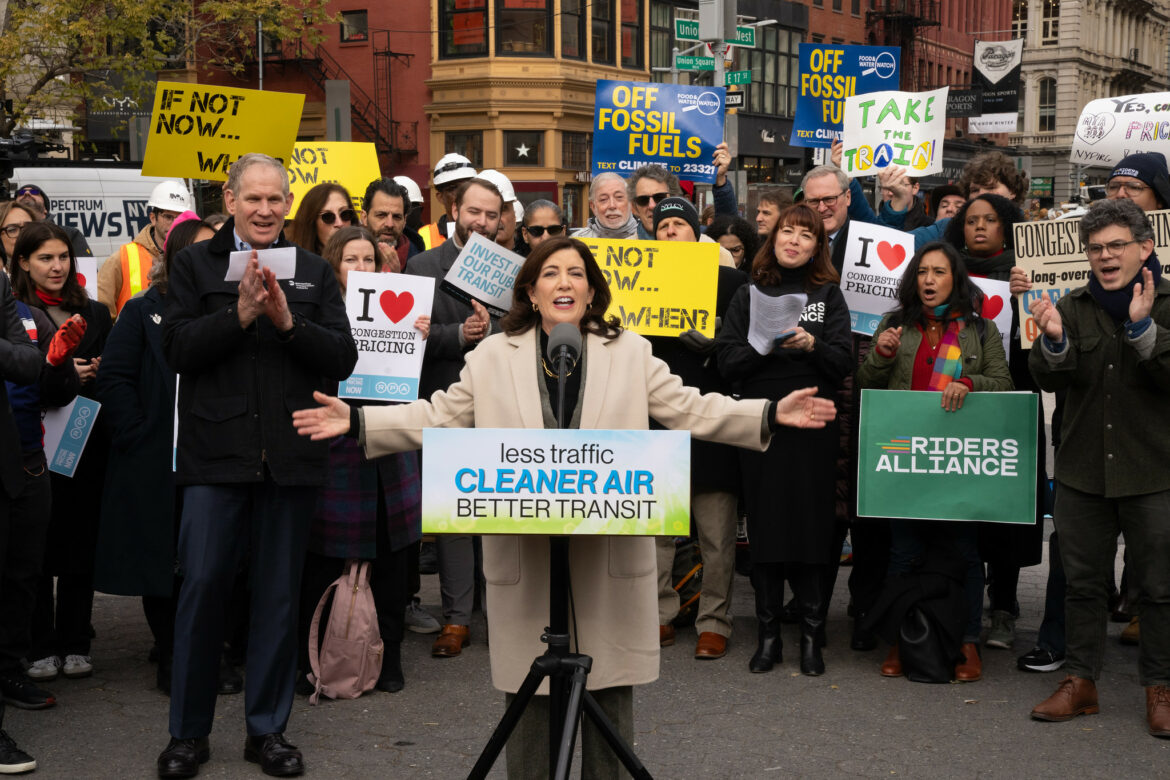In the face of climate change, the MTA must deal with excessive heat in its subway system and find ways to keep over 3 million daily riders cool.


Left: A fan blowing over passengers in the Times Square station. Right: The 34 St-Hudson Yards station, which has been fitted with integrated cooling technologies. (Credit: Jayleen Torres, Emmanuel Brown)
This story was produced by student reporters in City Limits’ CLARIFY News program, with instruction and editing by Julian Roberts-Grmela.
As 19-year-old Clara Medeiros steps into the 1 train, she’s met with an overwhelming heat, forcing her to scramble in search of a chilled car. This is routine for Medeiros, who takes the train every day to the Borough of Manhattan Community College.
“I’ve witnessed incidents of people fainting,” said Medeiros. “It can get really uncomfortable and unsafe for passengers, especially during the hot months.”
Over 3 million commuters each day rely on the MTA’s subway service, just like Medeiros. Subway cars have recorded temperatures as high as 98 degrees, and stations as high as 95 degrees. While the MTA says that 99 percent of trains have functional air conditioning, many commuters told City Limits they’ve encountered gaps in the cooling system.
For Jordan Romano, a 24-year-old retail clerk, the lack of functional air conditioning is most pronounced on subway lines that are numbered. Gothamist reported this summer that subway cars on the 1 train were particularly hot.
“You get on the train and it’s like, ‘Oh my God, it’s so hot, and I need to leave so I don’t die,’ and then the door’s locked, and you’re stuck in there,” Romano said.
Although Romano’s main grievances lie with train cars, others are more concerned with the stations’ temperatures. Michael Vodzogbe, a 23-year-old student attending SUNY Oswego, said subway platforms are “ridiculously hot.”
“My problem is really with the station itself. It’s always hot, dirty, nasty, funky, musty, all that,” Vodzogbe said. “It feels like I’m in pollution. Like the fumes, I can taste the heat.”
The heat is more than just an annoyance, though. Health Matters, New York-Presbyterian Hospital’s official media outlet, says heat exposure can lead to heat exhaustion, symptoms of which include sweating, nausea, and an accelerated heartbeat. With extended heat exposure, heat exhaustion can lead to heat stroke, which can be deadly.
No one is safe from heat stroke, but groups like older adults, those with chronic health conditions, and people who are less able to communicate their discomfort—such as small children—are most at risk, according to Health Matters.
Karen Carpenter, a 65-year-old theater director, has experienced these difficulties first-hand. “I carry a little fan with me, and I carry ice water,” Carpenter said. “Luckily, because I have a cane, people usually give me a seat, so at least I get to sit down.”
The often deep and outdated designs of many subway stations can make the task of keeping people cool a daunting one, according to Drew Maggio, the technical director of Highmark Building Efficiency. Maggio worked alongside the MTA on his capstone project at Stevens Institute of Technology to investigate overheating in subways and their stations.
“Most subway tunnels are designed to take advantage of an effect known as ‘piston wind.’ Just like the piston in a bike pump, a train entering the station displaces air and forces it out through sidewalk grates or [a] station entrance,” said Maggio. “As the train departs the station, it draws fresh outside air into the station behind it, similar to a syringe being filled when the plunger is raised.”
The cooling of subway cars comes at a cost: the heat produced by air conditioners on subways is expelled into the stations, adding to the discomfort. “Stations deeper underground are more susceptible to this ‘sticking effect’ because the heat is absorbed into the surrounding earth over time,” Maggio noted, explaining why deeper and older stations are frequently much hotter.
During heat waves, the MTA deploys additional staffers to conduct “heat patrols” that check stations and train cars for potential issues, officials said at a press conference earlier this summer outlining its heat mitigation efforts.

Marc A. Hermann / MTA
MTA officials providing an update on plans to mitigate heat in the transit system on Jun 18, 2024, ahead of a heat wave.The MTA has also built integrated cooling systems in select stations, including those along the Second Avenue line, the South Ferry Terminal, and 34 St-Hudson Yards, all of which were built between 2009 and 2015. The Grand Central-42 St 4/5/6 platform has been retrofitted with air coolers, while fans have been added to improve circulation at the Times Square-42 St Shuttle platform, Grand Central 7 platform, 14 St-Union Square 4/5/6 platform, Wall Street 2/3, and Bowling Green 4/5 stations.
Police officer Rob Almanza, 26, who is stationed in 34 St-Hudson Yards eight hours a week, believes that there’s a difference, saying the station has “better airflow” than others and that the “air feels clean.”
For stations with fans, the reviews are mixed. Even though the fans are supposed to cool passengers down, some say they don’t notice a difference. At the Times Square-42 St station, Jason Scurti, a 53-year-old attorney and frequent subway rider, said platforms with fans, like the one he was standing on, “seem pretty much the same” as those without.
In September, the MTA put out a request for information for cooling technologies on subway platforms, particularly for passenger-occupied portions of stations. In a press release accompanying the request, the MTA highlighted the urgency of addressing extreme heat.
“According to the New York City Panel on Climate Change, [there] will be up to three times as many days with temperatures over 90 degrees and up to nearly four times as many heat waves in the 2030s compared to recent years,” the agency said.
Unfortunately for New Yorkers, additional solutions likely won’t be clear until the MTA unveils its 2025-2029 Capital Program in the fall. The program, which details the MTA’s budget and projects for the next five years, will be crucial to the future of the MTA’s climate resiliency efforts. Long term projects such as flood prevention will be funded by the capital budget, while smaller repairs to air conditioners fall under the operating budget.
That plan certainly will not solve all of the MTA’s problems, as the MTA faces a significant financial shortfall that threatens its climate resilience projects. State Comptroller Thomas P. DiNapoli estimates a $25 billion gap in the 2025-2029 capital program, partially due to the recent pause on congestion pricing that has forced the MTA to delay $16.5 billion in essential infrastructure improvements.
Congestion pricing’s pause has led to doubts from environmentalists over whether a sufficient amount of money will be allocated to dealing with environmental problems and other high-priority work. Officials have warned that plans to expand underground air circulation are in jeopardy, largely due to the delay of congestion pricing, which would have raised $1 billion each year.
The mounting uncertainties have led to advocacy groups calling for Gov. Kathy Hochul to reinstate the congestion tolling plan.
“Without congestion pricing, not only will the MTA have to cut essential capital upgrades, it will also be forced to cut service and resiliency projects in future capital programs,” said Danny Pearlstein, the policy and communications director of Riders Alliance, a group dedicated to fighting for better public transit in New York.
Hochul has maintained that congestion pricing—which would have tolled drivers below 60th Street in Manhattan, most of them at the cost of $15 a day—is too much of a financial hardship.
“For over 100 years, we have been successfully funding the MTA. There are other sources of funding,” the governor said on WNYC’s All Things Considered this week, saying she will explore alternative sources with lawmakers when the state legislative session resumes in January. “We will make up the difference. I am committed to making sure that the capital plan is funded.”

Don Pollard/Office of Governor Kathy Hochul
Gov. Hochul at a rally in support of congestion pricing in 2023. She backtracked on that support in June, halting the tolling plan just weeks before implementation.While not cheap, there are solutions to heat-proofing transit stations that have been proven successful in Europe and Asia, including screen doors and dampers (doors in air ducts that open and close) that reduce the heat going into stations by taking advantage of piston wind, according to Maggio.
He believes that the MTA should remodel older stations to include cooling technologies, as many stations are too old to be fitted with effective cooling methods. While the obvious obstacle is the cost, Maggio believes he has a solution: selling off excess thermal energy. A similar effort has been tried out in London, where energy generated by the Underground is being used to heat homes.
The MTA could have a “near 100 percent profit margin with relatively few up-front investments,” according to Maggio, allowing for the project to fund renovations for subway stations. It would also help the battle against climate change, as buildings currently produce 50 percent of the city’s total carbon output but could produce less with this plan.
While progress has been slow, the MTA has recognized the importance of the issue, he said. “They are cooperating with engineering firms, building owners, and NYSERDA to perform feasibility studies,” said Maggio. “They’ll be quantifying the heat available for recovery, and developing a framework so that this can be replicated across the city.”
Even if the MTA follows Maggio’s proposal, there is still much work to be done, and there will still need to be more funding to maintain air conditioners and build newer stations. Many transit advocates, like Riders Alliance’s Pearlstein, believe the only way forward is to raise funds through congestion pricing.
“Governor Hochul needs to implement congestion pricing so the MTA can afford to replace aging train cars with faulty air conditioning and run frequent service so riders aren’t stuck on overheated platforms,” said Pearlstein. “The MTA employs 70,000 people and moves 7 million people every day. No one has to love it, but New York depends on it utterly.”
City Limits’ youth journalism program is generously supported by the Pinkerton Foundation, Harman Family Foundation and DJ McManus Foundation. Click here to apply for the Fall 2024 session of CLARIFY.
To reach the editor, contact Jeanmarie@citylimits.org









One thought on “Another Hot Summer Tests the MTA’s Cooling Efforts”
Previous generations of NYC Transit bus and subway riders until the late 1960’s had to rely on overhead fans and open windows for relief from excess summer heat. In 1967, NYC Transit introduced the first ten air conditioned subway cars operating on the old IND system (Independent municipal NYC built, financed and operated A, C, E. F & G lines). It was not until 1975, that air conditioned subway cars were introduced on the old IRT (NYC private franchised Independent Rapid Transit system operated 1, 2, 3, 4, 5, 6, 7, Franklin Avenue and Times Square shuttle lines). Subsequently, this also included the old BMT (NYC private franchised Brooklyn Manhattan Transit system B, D, J, L, M, N, Q, R, W & Z lines), It took until 1982 to retrofit all the original IRT “Redbird” series subway cars. By 1993, 99% of the NYC Transit 6,000 subway cars were air conditioned with the exception of a handful running on the NYC Transit #7 Flushing subway line.
Air conditioned buses were non existent during the 1964-65 New York Worlds Fair. Air conditioned buses were still a novelty. In 1966, NYC Transit purchased 600 buses with this new feature. Subsequently, all future new buses would include air conditioning. By the 1990’s, 100% of the bus fleet was air conditioned..
Larry Penner — transportation advocate, historian and writer who previously served as a former Director for the Federal Transit Administration Region 2 New York Office of Operations and Program Management. This included the development, review, approval and oversight for billions in capital projects and programs for New York Metropolitan Transportation Authority NYC Transit bus, subway and Staten Island Railway, Long Island and Metro North Rail Roads, MTA Bus, NJ Transit along with 30 other transit agencies in NY & NJ.